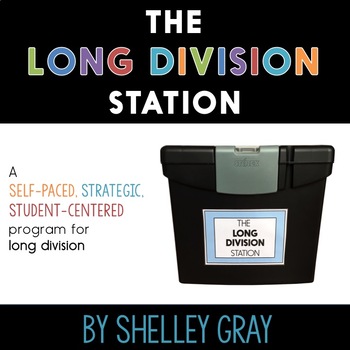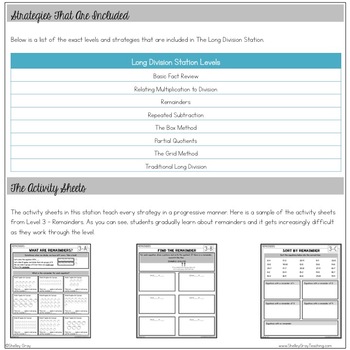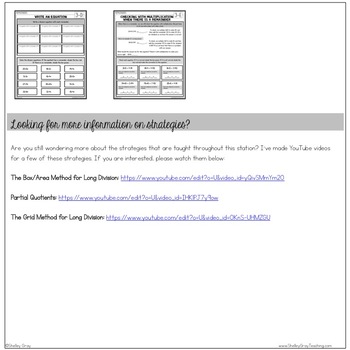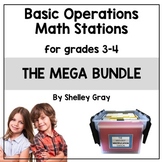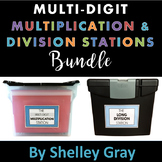The Long Division Station: self-paced, student-centered
- Zip
What educators are saying
Also included in
- This MEGA Bundle includes all of the self-paced, student-centered Math Stations for Grades 3-4 for BASIC OPERATIONS (addition, subtraction, multiplication, and division). This bundle does NOT include The Fraction Station.This bundle includes EIGHT math stations that literally have the power to transPrice $112.00Original Price $143.92Save $31.92
- This is a discounted bundle of long division resources.Please view the bundle contents to see exactly what is included.Price $36.99Original Price $47.49Save $10.50
- This bundle includes both the Multi-Digit Multiplication Station and the Long Division Station. Your students will move through a series of progressive strategies in a self-paced manner that will ensure that each student is appropriately challenged at all times. For full details on these stations, pPrice $31.50Original Price $35.98Save $4.48
Description
SEE ALL MATH STATIONS FOR ADDITION, SUBTRACTION, MULTIPLICATION, DIVISION, and FRACTIONS HERE
This station also included in the Grades 3-4 Basic Operations Math Stations MEGA Bundle. This includes all of the Math Stations for Basic Operations for Grades 3-4, at a discount. See that Mega Bundle HERE.
This Long Division Station is a follow-up to the best-selling Division Station for basic division facts. If your students do not yet know their basic facts, find the original Division Station HERE.
Do you want to implement more mental math strategies into your classroom, but don’t know where to start? Do you already teach mental math, but want to work more strategically to target your students more effectively? This is going to be the solution that you have been looking for.
The Long Division Station integrates simple principles of student engagement including power, fun and choice. These basic principles will engage, motivate, and ensure success for all learners in your classroom.
So, how does it work?
Well, it’s really quite simple. Students work through a series of activities for each level. They complete the activities, self-check using the prepared answer keys, and keep track of their progress using their personal tracker. At the end of each level, the student asks the teacher for a quick, informal, one-minute oral quiz. If he knows the strategy, he moves to the next level. If not, he simply practices a bit more until he feels ready.
This process is entirely student-run. It is a beautiful thing to sit back and watch your students “running the show.” After the first week of this program, you will notice your role switching from that of teacher to that of facilitator.
Why do students love this approach so much? It’s easy: they have power! They have freedom! They are truly in control of their own learning. And THAT results in highly motivated students who love to learn.
Add to that an effective order of teaching the strategies that really makes practical sense, and you will have students who feel smart, successful and engaged. It’s just that simple. Your students are going to love this.
You are going to be noticing some pretty big changes within your math instruction once you start using this resource:
Your teaching will become more effective and strategic. Finally! An organized, efficient way to teach long division. The work is done for you.
The amount of marking that you have to do will decrease, as students are responsible for their own assessment. (Of course you’ll be doing observational assessment throughout, but you will be doing NO marking.)
Once you prepare The Long Division Station, it can be used for at least a couple of months – that’s one less center that you need to worry about!
Your students will become reflective as they develop metacognition.
Your students will become motivated mathematicians. Finally, they can all work to a level that is appropriate. That’s motivating!
Your students will experience success on a regular basis, as a result of working at an appropriate level.
Your math class will become student-centered. Your students are truly in control of their own learning.
BIG GOALS
Long division can actually be quite a controversial topic when it comes to choosing the strategies that we should teach. On one end, we have strategies that have been used for decades, but that don’t necessarily involve a lot of number sense understanding, such as traditional long division. On the other end, we have strategies that are sometimes referred to as “new math” that encourage deep understanding of number. This includes strategies such as partial quotients and the box/area model. These sometimes appear more time consuming than more traditional methods, but they do result in excellent number sense understanding.
So how do we choose which ones to teach?
My personal opinion is that we should encourage a deep understanding of number whenever possible. It is essential that students understand place value concepts when they divide, because then the process of division makes sense, rather than just being a series of steps to follow to result in an answer.
However, I do still think that there is a place for traditional methods as well. Students who possess good number sense understanding can often thrive with long division and other similar methods. Once we have a solid number sense foundation, the goal becomes efficiency – getting a correct answer as quickly as possible. Traditional long division may be the most effective strategy for SOME of your students.
For this reason, I have included both traditional, and non-traditional methods in this station. The Long Division Station begins with strategies that teach and reinforce number sense.
If you have students who struggle with long division, you will likely choose to have them stop after the partial quotients level.
However, if you have students who are ready for a challenge, they can move into the final couple of levels which include the grid method and traditional long division.
This approach will ensure that each student in your class possesses the strategies that they need in order to be successful. It will also allow you to automatically differentiate to different ability levels.
This approach will ensure that each student in your class possesses the strategies that they need in order to be successful. It will also allow you to automatically differentiate to different ability levels.
Please see the PREVIEW file for a full preview and all of the information you need.
Thank you for your interest,
Shelley Gray

